
Shock Corridor is a 1963 American psychological thriller film starring Peter Breck, Constance Towers, and Gene Evans. Written, directed and produced by Samuel Fuller, it tells the story of a journalist who gets himself intentionally committed to a mental hospital to solve a murder committed within the institution.

The More the Merrier is a 1943 American romantic comedy film produced and directed by George Stevens, and starring Jean Arthur, Joel McCrea, and Charles Coburn. The film's script—from Two's a Crowd, an original screenplay by Garson Kanin (uncredited)—was written by Robert Russell, Frank Ross, Richard Flournoy, and Lewis R. Foster. Set in Washington, D.C., the film presents a comic look at the housing shortage during World War II.

Howards End is a 1992 historical romantic drama film directed by James Ivory, from a screenplay written by Ruth Prawer Jhabvala based on the 1910 novel by E. M. Forster. Marking Merchant Ivory Productions' third adaptation of a Forster novel, it was the first film to be released by Sony Pictures Classics. The film's narrative explores class relations in turn-of-the-20th-century Britain, through events in the lives of the Schlegel sisters. The film starred Emma Thompson, Anthony Hopkins, Helena Bonham Carter and Vanessa Redgrave, with James Wilby, Samuel West, Jemma Redgrave and Prunella Scales in supporting roles.
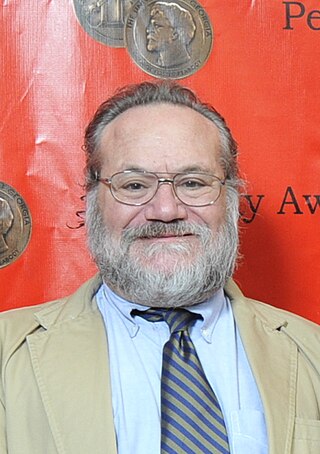
Louis Black is an American journalist and businessman who is the co-founder of The Austin Chronicle, an alternative weekly newspaper published in Austin, Texas, and was the newspaper's editor from its inception until his retirement on August 8, 2017. He has written over 600 articles in his column in that newspaper. Black is also the co-founder of the South by Southwest Festival, also located in Austin, although the festival operates separately from the Chronicle. He also is a founding partner in Toronto's North by Northeast music and film festival.
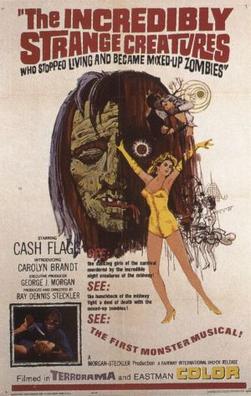
The Incredibly Strange Creatures Who Stopped Living and Became Mixed-Up Zombies is a 1964 American monster movie produced and directed by Ray Dennis Steckler. Steckler also starred in the film, billed under the pseudonym "Cash Flagg".

Janis Carter was an American stage and film actress who performed throughout the 1940s and into the 1950s. During the mid-1950s, she began working regularly on television, co-hosting with Bud Collyer the NBC daytime game show Feather Your Nest.

A Symposium on Popular Songs is a special cartoon featurette made by Walt Disney Productions in 1962. It features songs that were written by the Sherman Brothers, with music arrangements by Tutti Camarata. The Shermans also co-wrote the screenplay but are not credited for this. Host Ludwig Von Drake invites his audience into his mansion where he tells all about popular music through the years, introducing several songs illustrated with stop-motion photography. The film was nominated for an Academy Award for Best Animated Short Film.

Die Nibelungen is a two-part German series of silent fantasy films created by Austrian director Fritz Lang in 1924, consisting of Die Nibelungen: Siegfried and Die Nibelungen: Kriemhild's Revenge.

Bluebeard is a 1944 American historical film noir directed by Edgar G. Ulmer, starring John Carradine in the title role. The film also stars Jean Parker. The film is based on the famous French tale Barbe bleue that tells the story of a violent nobleman in the habit of murdering his wives and the attempts of one wife to avoid the fate of her predecessors. The film is registered in the public domain.
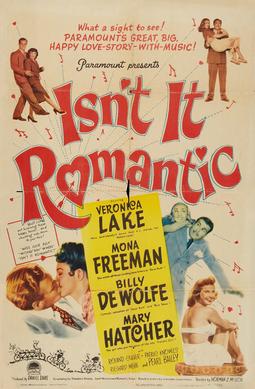
Isn't It Romantic? is a 1948 American black-and-white comedy musical film from Paramount Pictures, directed by Norman Z. McLeod and starring Veronica Lake and Billy De Wolfe. Supporting actors included Mona Freeman, Richard Webb and Pearl Bailey. Although it takes its title from a 1932 song by Richard Rodgers and Lorenz Hart, it is based on a novel called Gather Ye Rosebuds by Jeannette C. Nolan.

Too Many Kisses is a 1925 American silent comedy film directed by Paul Sloane that is based on the John Monk Saunders story "A Maker of Gestures."
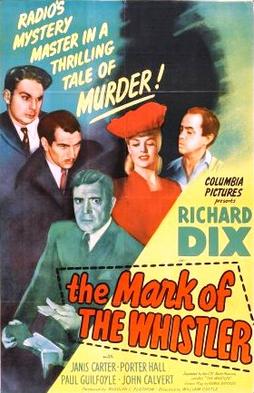
The Mark of the Whistler, aka The Marked Man, is a 1944 American mystery film noir based on the radio drama The Whistler. Directed by William Castle, the production features Richard Dix, Porter Hall and Janis Carter. It is the second of Columbia Pictures' eight "Whistler" films produced in the 1940s, all but the last starring Dix.

Voice of the Whistler is a 1945 American mystery film noir directed by William Castle and starring Richard Dix, Lynn Merrick, and Rhys Williams. It was the fourth of Columbia Pictures' eight "Whistler" films produced in the 1940s, all based on the radio drama The Whistler.

Hard Boiled Mahoney is a 1947 American comedy film directed by William Beaudine and starring the comedy team of the Bowery Boys along with Teala Loring and Betty Compson. It is the sixth film in the series produced by Monogram Pictures.
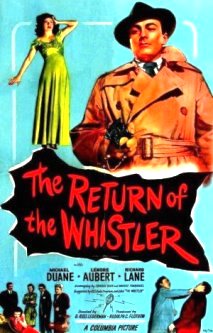
The Return of the Whistler is a 1948 American mystery film noir based on the radio drama The Whistler. Directed by D. Ross Lederman, the production features Michael Duane, Lenore Aubert, and Dick Lane. This is the eighth and final entry in Columbia Pictures' "Whistler" series, produced in the 1940s. This was the only film in this series that did not star Richard Dix.

Singapore is a 1947 American film noir crime romance film starring Fred MacMurray, Ava Gardner, and Roland Culver. Directed by John Brahm, the film was remade as Istanbul (1957) with the location moved to Turkey, and Errol Flynn and Cornell Borchers in the starring roles.

Beware of Pity is a 1946 British romantic drama film directed by Maurice Elvey and starring Lilli Palmer, Albert Lieven and Cedric Hardwicke. It is based on the 1939 novel of the same name by Stefan Zweig. A paraplegic young baroness mistakes compassion for love. The film's costumes were designed by Cecil Beaton. It was made by Two Cities Films at Islington Studios. The film was not a great popular success outside the Soviet Union.

Ace of Aces, also known as Bird of Prey, is a 1933 American pre-Code war film based on the story "The Bird of Prey" by World War I pilot John Monk Saunders that explores how war can turn a man's moral compass from pacifism to warmonger. Starring Richard Dix, it was similar to many of the period films that appeared to glorify the "knights of the air", but was more complex, examining the motivations of those who choose to go to war.

The Whistler is a 1944 American mystery film noir directed by William Castle and starring Richard Dix, Gloria Stuart and J. Carrol Naish. Based on the radio drama The Whistler, it was the first of Columbia Pictures' eight "Whistler" films starring Richard Dix produced in the 1940s. The film will be under copyright until 2040 due to renewal.
The Tartars/I Tartari is a 1961 Italian-Yugoslavian epic historical Technicolor film directed by Richard Thorpe and starring Victor Mature and Orson Welles. It is one of the sword-and-sandal genre films made in Italy in the 1950s and early 1960s.



















